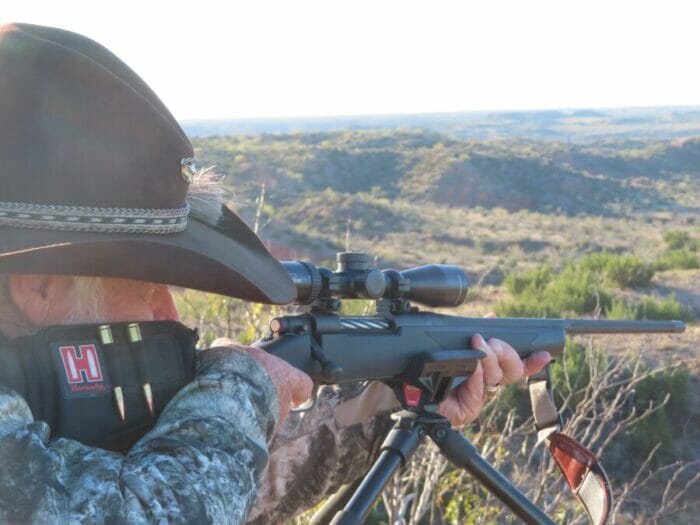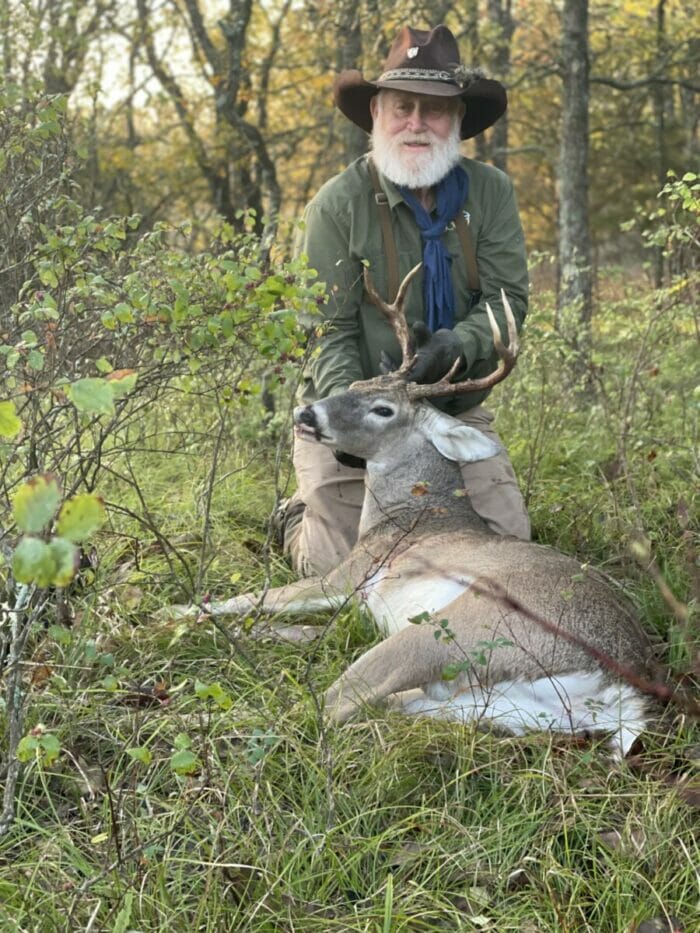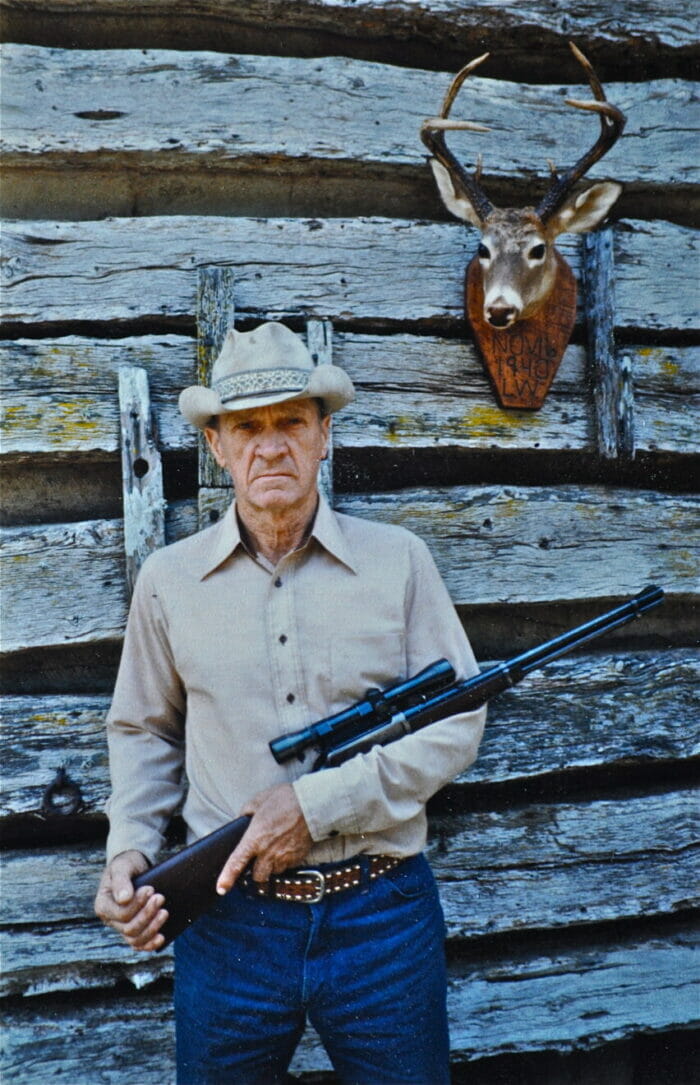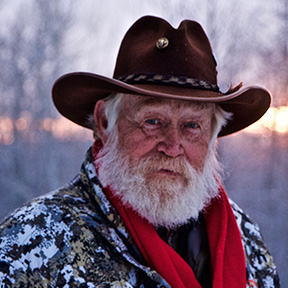An Old Six Point
“He’s definitely mature. Notice two things about him, his darkly stained tarsals, all the way down to his ankles, and the flappy jowls under his lower jaw, plus the nearly square muscle that extends all the way from his lower jaws to his brisket. Oh…that’s three things.” I commented to the camera in Brandon Houston’s hands.
A hundred and twenty yards away, the old six-point buck fed on the edge of the food plot planted with triticale and Austrian winter pea. I had watched him for a while, wanting to be certain he had at least a 13-inch inside spread. Knowing his forward-looking ear-tip-to-ear-tip spread was at least thirteen inches helped make my decision.
Management Perspective
The hunt invitation had come from David Cotton and his father Edgar, so Brandon and I, through our H3 Whitetail Solutions consulting outfit, could take a look at their property and, while there, take a deer. The Cotton’s property is some of the finest wildlife habitats I have seen in the eastern half of Texas, particularly regarding habitat diversity and vegetation. It lies in an area that has a history of producing big antlered whitetail deer.
Knowing there were some huge antlered bucks in the area, I had to make a decision. Do I pass on the old 6-point in hopes of seeing a bigger antlered buck, or do I take the 6-point, which would be the proper thing to do to help with their existing management program?
From a genetic perspective, I was not concerned about the 6-point. The area’s buck-to-doe ratio was approximately one buck to 2 does. The chances of that buck breeding more than one doe were slim. Secondly, research conducted in South Texas based on procuring DNA on hundreds of deer on the property was showing some of the best-antlered bucks were not necessarily being sired by big antlered bucks. Those with less than fantastic antlers were actually siring the best-antlered bucks. With that said, we cannot forget that half of an offspring’s genetics comes from the doe, and much of what a young deer learns about what to eat comes from the mother.
From a herd and management perspective, taking the old 6-point was the proper thing to do. Removing him would allow the forage eaten by this buck with less than impressive antlers to be eaten by a deer with the potential for bigger antlers. And having seen several impressive young bucks the evening before, I liked the idea of removing this buck so the younger bucks would have more available food.
After mulling over the short and long-term effects and benefits of removing the old 6-point, I decided if he gave me a shot, I would take him.
Rifle Combination
Decision made, I raised my Mossberg Patriot .270 Win, topped with a Trijicon 3-9×40 Huron scope. I had chambered a Hornady 145-grain ELD-X Precision Hunter round as soon Brandon, and I had climbed into the raised, comfortable blind. I tracked the buck through the scope, set at 6x, as he walked behind a screening of brush, safety pushed to fire.
Earlier I had adjusted my Patriot’s trigger system down to 2 ½ pounds of pull, which the gun owner can easily do. It is relatively simple. The reduced trigger pull, which can be adjusted from 7 down to 2 pounds, helps make the Patriot an extremely hunting-accurate rifle. From the time at the bench, I knew shooting Hornady’s Precision Hunter ammo, the rifle was nicely accurate, consistently shooting 1-inch, 3-shot groups at the range. My only “additions” to the economically priced Mossberg rifle was to mount the Trijicon Huron scope and put a Hornady cheek pad on the stock so my eye was directly in line with the center of the scope when I brought it to my shoulder.
I admit I like the Mossberg Patriot. Over the years, I have shot many different rifles, from economy models to upper-end semi-custom and custom rifles built in America and abroad. I am continually amazed by the feel and accuracy of the Patriot, which not only has a great trigger but also has a fluted barrel. I paid essentially $500 for mine, which came topped with a Vortex variable scope. I removed and replaced the Vortex with the Trijicon Huron, a scope I have great confidence in and which was designed for the American deer hunter.
The Patriot has a drop box magazine which I truly appreciate. I often hunt where it is illegal to have a loaded rifle in a vehicle when hunting or crossing a public road. With the Patriot’s drop box magazine, I can quickly remove and replace it when it becomes necessary.
From time on the range, I knew my Mossberg/Hornady/Trijicon combination would do all I asked of it if I did my part.
Reflections
The buck stopped broadside and looked over his shoulder at an approaching doe. I took a deep breath, let it all out, and gently squeezed the trigger. At the shot, the buck bucked and ran. I quickly and easily bolted in a fresh round and was about to shoot a second time, but he fell before I could squeeze the trigger. I liked the way the Patriot had swung on the running deer. I kept the Trijicon’s crosshair trained solidly on the downed buck. If he so much as twitched, I would shoot him a second time. I firmly believe that when you shoot an animal, regardless of what you use, the proper and wise thing is to quickly reload and stay on the animal for at least 30 seconds. If it so much as even stirs, shoot again, reload and continue watching. Far too often, I have seen a hunter shoot an animal, then without reloading and staying on the animal, turn to celebrate with whoever is with them, thinking the animal was dead. While the celebration is going on, the animal gets up and runs away. Sometimes those animals are recovered later, but they are often never found!
When I was sure he was down for good, we crawled out of the blind and walked to where it lay. After a quick prayer of thanks, I reached down to grab the buck’s head. Many years as a professional wildlife biologist took over, and I immediately poked a finger in the deer’s mouth to check the wear on his teeth. Both premolar and molars were worn nearly to the gum line. He was old likely eight years or older.
After admiring him, I accepted Brandon’s congratulatory hand. We did some “tv stuff,” took a few still photos, then called David Cotton to come to get us to take my buck back to camp. There I would gut and cape him, skin the rest of the carcass, then hang it to cool.
That night after visiting with fellow hunters Luke Clayton, Jeff Rice, the Cottons, and Brandon, when all had gone to bed, I walked outside and sat on the front porch. A cooling wind blew, gently rustling nearby oak leaves. Off in the distance, owls hooted, and coyotes yapped, creating a truly unique Nature’s symphony. Loved it!
Sitting in the dark, I reflected on a photo of my dad, Lester, which I had taken years ago. Dad, in 1940 had shot a gnarly 6-point. He mounted the skull plate and antlers on a plaque he had made from a cedar board. There he carved the date and his initials.
Immediately after college, I started doing taxidermy. After taking an 8-point not far from where Dad had taken the 6-point buck, I used my cape to mount dad’s antlers. I did so for a birthday gift.
The photo shows Dad with his mounted 6-point holding his deer rifle, a Winchester Model 94, .30-30 Win. It is one of my favorite photos!
With my recent 6-point, I am having Double Nickle Taxidermy do a skull mount. In time I will put it on a plaque similar to the one my dad did years ago and hang it next to my Dad’s in my office.
My eastern Texas 6-point is special in several ways. Among other things, he was an old, mature buck who had survived for many years. Taking him, too, solidified my commitment to the Cotton’s wildlife management program. In the future, I will try to take a bigger antlered buck, but for the time being, it was the perfect buck to take.
Incidentally, the 6-point from the Cotton property was not the only one I took during the 2022 hunting season. There was another, totally different and even older. I shot it with my Taurus .454 Casull Raging Hunter handgun. Therein lies another story to be told at another time!
Professional wildlife biologist/outdoor communicator, Larry Weishuhn, known to many as “Mr. Whitetail”, has established quality wildlife management programs on over 12,000,000 acres throughout North American and other parts of the world. He has hunted big game with rifle and/or handgun on six continents. Larry is a Professional Member of the Boone & Crockett Club, life-member of numerous wildlife conservation organizations including the Dallas Safari Club, Mule Deer Foundation, and Wild Sheep Foundation. He currently serves on the DSC Foundation Board of Directors, is one of three co-founders of the Texas Wildlife Association; is a member of the Legends of the Outdoors Hall of Fame and the Muy Grande Hall of Fame; he too, received the Zeiss Lifetime Achievement Award among many other honors.




